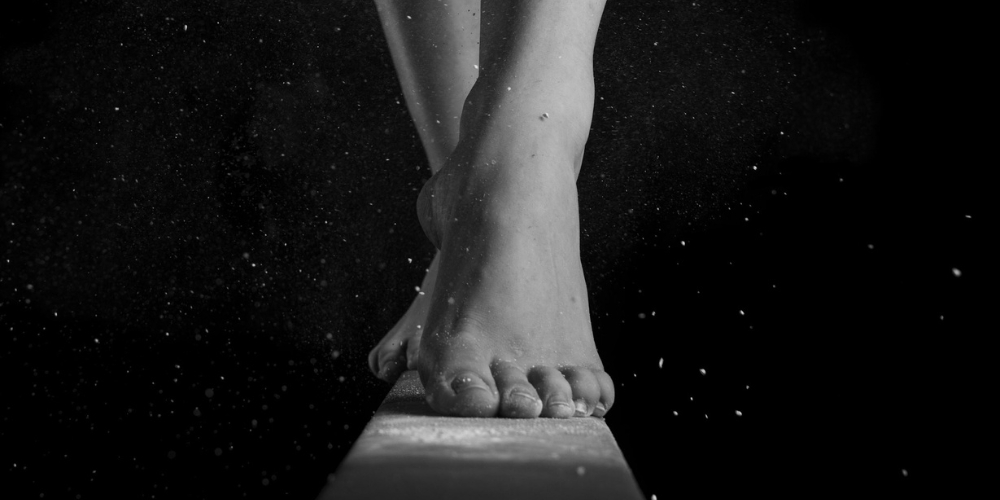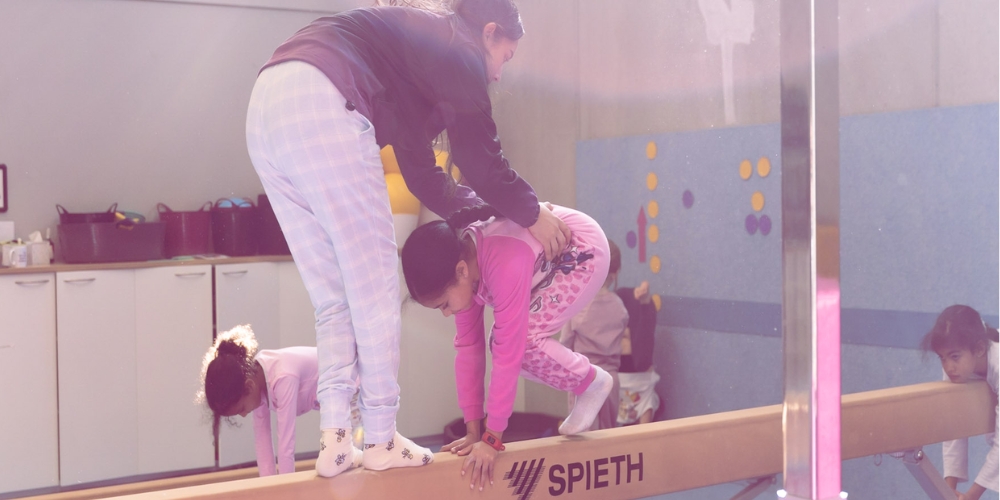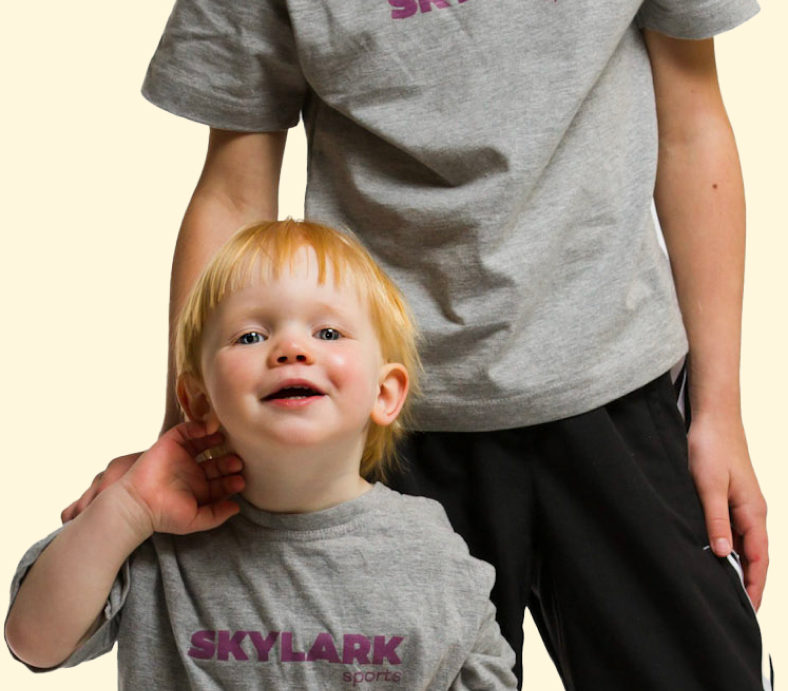Whenever we see balance beams, one thing comes to our mind - gymnastics! Sometimes, we would find our so-active kids somersaulting benches or performing gymnastic moves, acting like gymnasts.
Now, when we talk about an actual gymnastics balance beam, we're referring to a specific piece of equipment used in gymnastics routines. It's a narrow, rectangular beam elevated about four feet off the ground, and gymnasts perform a variety of skills and routines on it.
But what exactly is a balance beam, and why does it have such a grip on our budding gymnasts' imaginations? Let's break it down.

What is a Balance Beam?
Balance beam is the gymnastic apparatus where we often see our gymnasts perform a variety of graceful and precise movements.
During our training, we often focused on developing the necessary skills and techniques to navigate and execute routines on the balance beam. The balance beam is a key component in artistic gymnastics, and training on this apparatus involves a combination of physical conditioning, technical skill development, and mental preparation.
Brief history:
The balance beam has been rocking the gymnastics scene for quite a while. Back in the day, it started as a wooden thing with little standardization. But, as gymnastics got more serious, they had to ensure everyone was playing on a level beam.
Fast forward to the '70s when Nadia Comăneci blew everyone's minds with that perfect ten on the balance beam at the Montreal Olympics – talk about setting the bar high! Over the years, gymnasts have been flipping, twirling, and pushing the envelope, making the balance beam routines a jaw-dropping spectacle. From the classic routines to the mind-boggling difficulty of today, the balance beam has seen it all, and it's still the heart of women's gymnastics.
What is a Balance Beam Made Of?
Strength and simplicity come together in the creation of a balance beam. Balance beams are usually made of a mix of synthetic and wood elements. A non-slip material, such as suede or leather, covers the top surface where gymnasts perform, while the core, generally made of wood, provides stability. This material ensures that gymnasts demonstrate their skills on a stable yet grippy surface.
How long is a balance beam?
Britannica mentions that balance beams follow a standard length in gymnastics, measuring precisely 16 feet and 5 inches (5 meters) from end to end. This standardized length allows gymnasts to practice and perform routines consistently, whether in a training facility or a competition setting. The fixed length contributes to the uniformity and fairness of sports competitions.
Where is the balance beam used?
Gymnastics routines and competitions revolve around the balance beam. It is a common piece of equipment in rhythmic and artistic gymnastics. On the balancing beam, gymnasts showcase their power, flexibility, and grace via complex routines. The balance beam takes centre stage, pushing gymnasts to demonstrate their talents in the most exacting and demanding way possible, whether in local gymnastics clubs, worldwide championships, or the Olympic stage.

Most Common Balance Beam Gymnastics Routines
Gymnastics routines on the balance beam vary widely regarding difficulty, style, and choreography. However, certain elements and skills are commonly incorporated into routines at different skill levels. Here are some elements commonly seen in balance beam gymnastics routines:
Mounts and Dismounts:
Mounts are the ways gymnasts start their routines on the beam. This could involve various jumps, turns, or acrobatic elements.
Dismounts are the concluding elements where gymnasts dismount from the beam, often incorporating flips or twists.
Acrobatic Elements:
- Tumbling Passes: Series of flips or handsprings.
- Aerials: Cartwheels without hands touching the beam.
- Back Walkovers and Front Walkovers: Walking over the beam backward or forward without using hands.
Jumps and Leaps:
Various types of jumps and leaps, including split jumps, straddle jumps, wolf jumps, and switch leaps.
Turns:
Full turns, half turns, and other turning elements on one foot.
Balance and Artistic Movements:
- Scale: A position where the gymnast extends one leg straight backwards while leaning forward.
- Arabesque: A position where the gymnast extends one leg straight backwards while keeping the body upright.
- Attitude: A position where the gymnast lifts one leg backwards, bent at a 90-degree angle.
Connection of Elements:
Gymnasts are often required to connect various skills seamlessly, demonstrating fluidity and control.
Dance Elements:
Incorporation of dance elements, such as turns, jumps, and expressive movements, to showcase artistry.
Acro Series:
A combination of acrobatic elements performed consecutively, showcasing strength and precision.
Pivots and Turns on One Foot:
Various turns and spins are performed on one foot, showcasing balance and control.
Flexibility Elements:
Splits and other flexibility movements demonstrate the gymnast's range of motion.
Famous Balance Beam Performers
Simone Biles (USA)
Biles is a four-time Olympic gold medalist and 19-time world champion. She is known for her incredible difficulty and consistency on the balance beam.
Aly Raisman (USA)
Raisman is a two-time Olympic gold medalist and six-time world champion. She is known for her elegant and graceful style on the balance beam.
Catalina Ponor (Romania)
Ponor is a three-time Olympic gold medalist and four-time world champion. She is known for her powerful and dynamic routines on the balance beam.
Cheng Fei (China)
Cheng is a two-time Olympic gold medalist and four-time world champion. She is known for her high-flying acrobatics and difficult dismounts on the balance beam.
Shawn Johnson (USA)
Johnson is a two-time Olympic gold medalist and four-time world champion. She is known for her consistency and execution on the balance beam.
And speaking of awards and achievements, you might want to check out an article we published where we shared our proud moments so far through these years! Please see it here!
Frequently Asked Questions
What advantages can a balance beam offer?
The beam can aid in developing mental and physical abilities like perseverance, discipline, and attention, as well as physical abilities like strength, flexibility, and agility. To begin, beginners can start with basic activities like walking or sitting on the beam and work up to more difficult manoeuvres like jumps and turns.
What age is a balance beam good for?
The balance beam is suitable for various ages, with kids as young as 5 or 6 often starting in recreational gymnastics classes. It's adaptable, allowing young gymnasts to build confidence on lower beams before progressing to standard heights as they grow and develop their skills.
Why don't guys do a balance beam?
Men have their apparatuses in artistic gymnastics, and the balance beam is exclusive to women's gymnastics. Men typically focus on events like floor exercise, parallel bars, rings, vault, pommel horse, and high bar, each requiring unique skills and strengths.
Conclusion
So there you have it! Balance beams may look as normal as any other gymnastic equipment. But these platforms are among the most used apparatuses among successful and well-known gymnasts, turning a seemingly simple beam into a stage for extraordinary performances.

